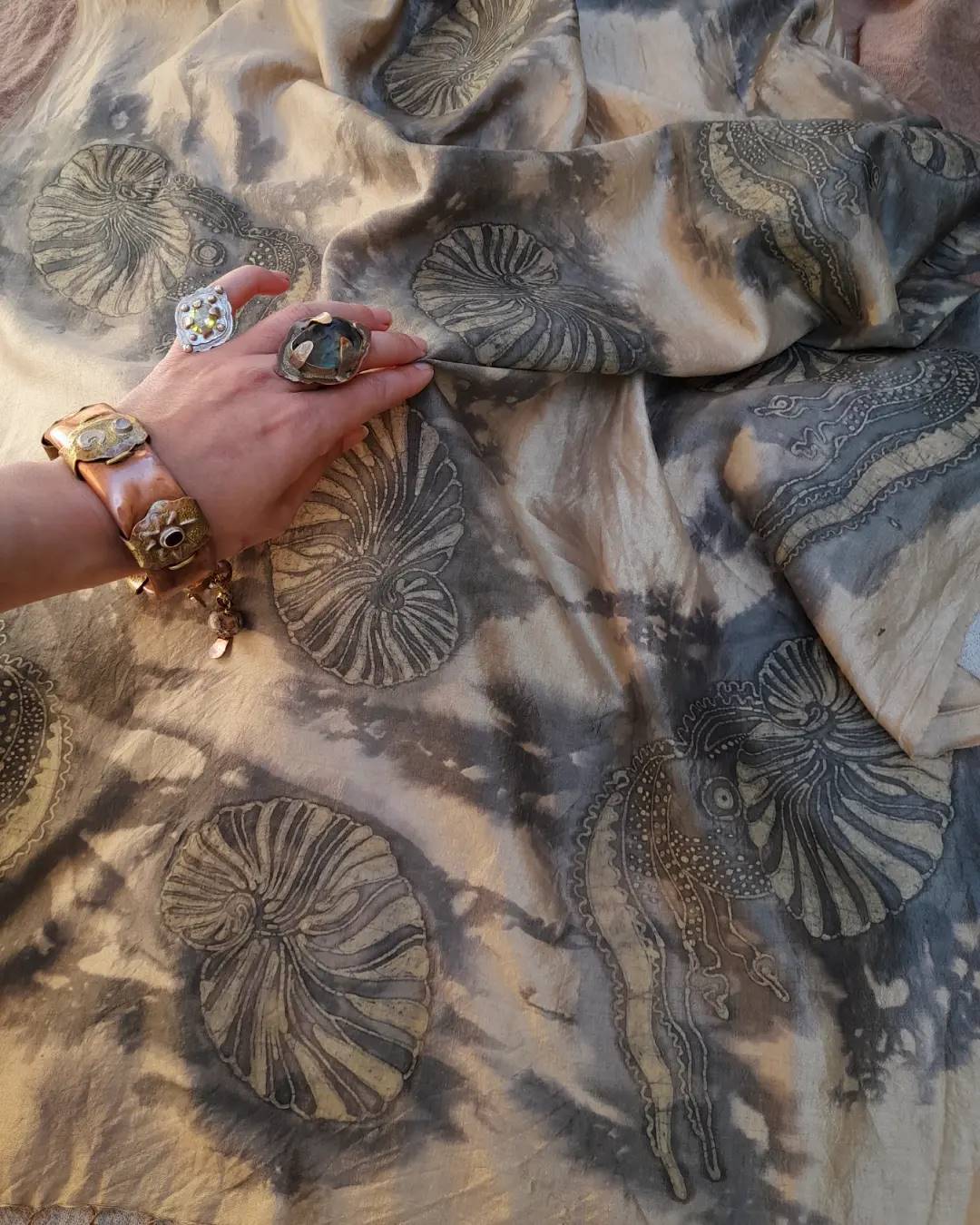
Nautilus silk batik, dyed with tea tree and snottygobble from my parent’s land in the great Southern region of Western Australia, and freesia flowers leftover from making enfleurage perfume. The silk is ethical peace silk, and the bee wax is sourced locally from a family meadery in Denmark, Western Australia. I fell in love with nautilus shells on a trip home, the first time I had brought my partner to where I grew up, and we saw the most incredible shell collection at a local museum. An experienced diver, he even gifted me some beautiful shells he had found, that I still keep next to our bed.

The black detail surrounding the nautilus is inspired by one of our favourite beaches, cosy corner, where the alum on the shore creates dark shimmering shadows as the sediment mixes with the white sand and gets pulled back and forth by the waves, I have fond memories as a child camping at this beach with my primary school, a very unconventional school at that, it was nestled amongst the forest down a burnt orange dirt trail, we did not have the confines of uniforms or shoes, we were allowed to climb trees, had a strong focus on art and even sang Michael Jackson’s heal the world, every morning (Looking back, the last part has not aged well, our principle also offered ten dollars to any kid who could bring back a tiger snake on one of our adventuring in the bush educational days, again, might not fly these days). I will never forget my mother picking me up after two days camping at the beach, with my long wild hair, in sand filled dreadlocks, The same salty wonderland I found out I was pregnant with my youngest daughter Élodie.

After years of using synthetic dyes from Indonesia and then the much less problematic, low impact ,fibre reactive Procion MX dyes (which aside from turquoise, and also the risks associated with breathing in the powder if not handled correctly, are surprisingly safe and environmentally sound, they also produce impressive results) I am making move to step away from the toxic materials that are sometimes exceedingly difficult to avoid when creating textiles, unfortunately the chemical mordants needed with most natural dyes (metallic salts) can be highly toxic, unless you use substantive dyes that do not need a mordant (I have had great success with tea tree, eucalyptus and loquat leaves), there is also the issue of water usage and amount of recourses used to boil the fabric and organic materials for many hours. While the colours are much softer than what you see in chemical dye, or mordanted fabric, I personally resonate more with the natural transient nature, and limited palette associated with forgoing the chemical additions. I enjoy the way colours shift and change, I have also had to adapt my process given that batik wax resist dying, cannot be heated, because it will melt the bee wax and destroy the piece, this has made me have a much deeper respect for the pieces I create because of the long labouring process required, the planning and thought, the problem solving.

Imagine if we respected cloth in the same way the ancients did, when fabric was incredibly valuable, each item being handed down and lovingly mended, the manner in which clothing is bought, and discarded is alarming and unnecessary, and the pollution caused by the textiles industry has caused monumental damage to the environment, not only by poisoning waterways during the dying process, and creating landfill, but by producing and using synthetic fabrics that shed fibres just by wearing, and washing, that become microfibres, which are non-biodegradable.
I have spent hours and hours, going around in circles with myself on this topic, trying to create in the gentlest ways possible, and even the most seemingly sustainable methods, can only look that way on the surface. For myself personally I have settled on peace silk (Where the silkworm is not killed for the silk cocoon, and they are treated in an ethical manner) and will be moving away from organic cotton towards flax and hemp, and while that will require a whole new adaption of its own, given the different feel and texture of the fabric, I am ready for the challenge.







